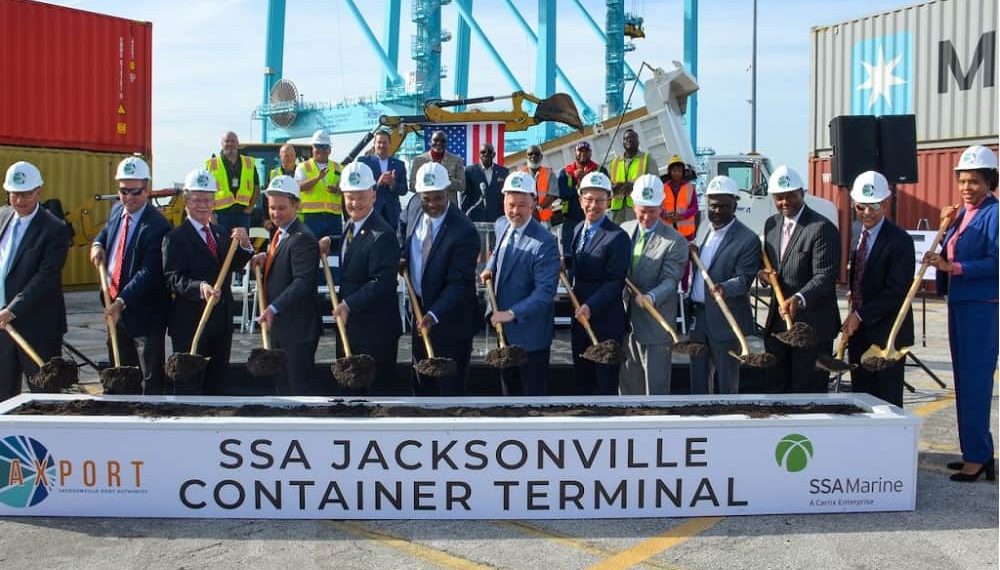Mark Buzby joined elected officials and leadership from JAXPORT and SSA Marine to break ground on a new state-of-the-art international container terminal at JAXPORT’s Blount Island Marine Terminal.
The SSA Jacksonville Container Terminal is an expansion of SSA’s current leasehold at Blount Island and includes $238.7 million in infrastructure and equipment upgrades. Operations will continue throughout the redevelopment, which is expected to be complete in 2023—coinciding with the completion of the federal project to deepen the Jacksonville shipping channel to 47 feet. Harbor Deepening is ahead of its original schedule and anticipated to be finished later that year, based on continued funding.
Phased yard improvements are underway at the terminal that will allow the facility to accommodate up to 700,000 TEUs (twenty foot equivalent units) annually. Berth upgrades are expected to be complete in 2021 and will allow the terminal to simultaneously work two post-Panamax vessels. The Jacksonville Harbor Deepening Project includes construction of a vessel turning basin that will allow larger vessels calling on the terminal to turn at Blount Island.
The SSA Jacksonville Container Terminal offers 80 acres of terminal operating space, with the option to grow up to 120 acres as space becomes available. The facility features three post-Panamax electric container cranes and terminal plans include the addition of three more state-of-the-art container cranes. The facility is expected to create or protect 3,500 jobs, in addition to attracting new businesses and jobs resulting from the terminal’s increased efficiency and capacity.
During the groundbreaking, Admiral Buzby formally presented JAXPORT with a previously awarded $20 million grant from the U.S. Department of Transportation. The grant will fund terminal enhancements that will allow the facility to accommodate more containers on an expanded footprint.
“An investment in the Port of Jacksonville delivers benefits for the local economy and for American workers. It is a central part of President Trump and Secretary Chao’s belief of investing in infrastructure to grow our economy and create jobs,” said Admiral Buzby. “This grant will also indirectly help support the jobs of the American civilian mariners who crew military sealift vessels that help us carry the fight wherever we must go.”
“Jacksonville’s port is a critical economic engine for our city, state, region and nation,” said Jacksonville Mayor Lenny Curry. “The cargo that moves through these docks every year generates jobs and economic opportunities that empower families throughout our community. The enhancements we’re breaking ground will help companies meet the growing demand and further enhance Jacksonville’s growing reputation as a logistics hub for the southeastern United States.”
“This facility represents a milestone in the evolution of our port,” said JAXPORT Vice Chairman Jamie Shelton. “Together, with the support of Secretary Elaine Chao, our federal, state and local partners, and SSA Marine—we are investing in our region’s future and ensuring JAXPORT can continue to create more jobs and economic opportunity for the people of Northeast Florida.”
“There is no doubt about it, Jacksonville’s port is on the rise,” said SSA Marine Vice President of Project Engineering and Implementation Ari Steinberg. “This public-private partnership enables SSA to provide a world-class facility for our customers while investing in Northeast Florida—a community in which we have proudly served for more than four decades.”
The SSA Jacksonville Container Terminal is a public-private partnership between JAXPORT and SSA Marine, with more than 65 percent of the landside improvements being funded by SSA.
The facility is a 4-mile dray from JAXPORT’s Intermodal Container Transfer Facility, offering direct service to and from Atlanta and Chicago, with additional service from Detroit. A recent economic impact study found that cargo activity at Jacksonville’s seaport generates more than 26,000 jobs in Northeast Florida and supports nearly $31.1 billion in annual economic output for the region and state.


































